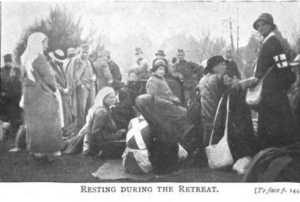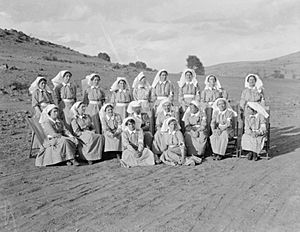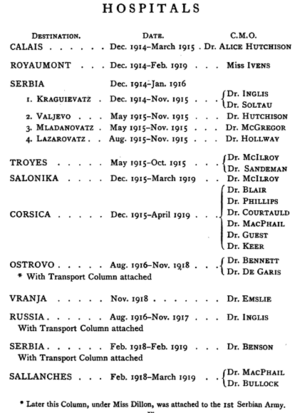Scottish Women's Hospitals for Foreign Service facts for kids
Quick facts for kids Scottish Women's Hospitals for Foreign Service |
|
|---|---|
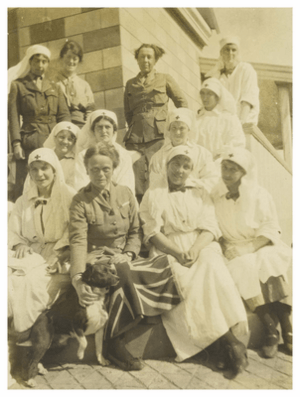
Elsie Inglis and other members of the S.W.H.
|
|
| Organisation | |
| Funding | National Union of Women's Suffrage Societies, Red Cross, donations |
| History | |
| Founded | 1914 |
| Closed | 1919 |
The Scottish Women's Hospitals for Foreign Services (SWH) was an amazing group started in 1914. It was led by Dr. Elsie Inglis. This organization provided nurses, doctors, ambulance drivers, cooks, and helpers. By the end of World War I, they had set up 14 medical units. These units served in places like Corsica, France, Malta, Romania, Russia, Salonika, and Serbia.
Contents
How It Started
When World War I began, Dr. Elsie Inglis was a leader in a women's rights group. This group was called the Scottish Federation of Women Suffrage Societies. It was part of the National Union of Women's Suffrage Societies (NUWSS). The NUWSS was led by Millicent Fawcett.
Dr. Inglis started the SWH as part of a bigger effort by women's rights supporters. The hospitals were paid for by donations from people and groups. The National Union of Women's Suffrage Societies and the American Red Cross also helped with money.
Millicent Fawcett wanted to include "Women's Suffrage" in the name. But Dr. Inglis thought this might cause problems. She felt the word "suffrage" could be seen as political. Even so, the letters "NUWSS" were on SWH papers and vehicles. Many French newspapers called their hospitals "Hospital of the Scottish Suffragists". The NUWSS also gave them money.
People were very generous with donations. After Dr. Inglis spoke in London, they quickly raised over £5,000. The Scottish Women's Hospitals were formed soon after World War I started. They were all-women groups. This gave medical women a chance to help. At the time, they were not allowed to join the Royal Army Medical Corps.
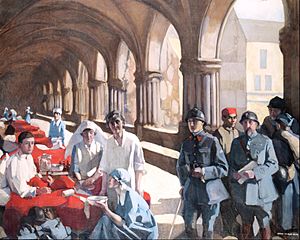
The main office for the SWH was in Edinburgh. There were also groups in Glasgow and London. They worked closely with the French Red Cross.
Dr. Alice Hutchison was the first SWH doctor sent to France. She set up the first hospital in Boulogne. While looking for a hospital building, a serious illness called typhoid spread. It affected Belgian refugees in Calais. Dr. Hutchison and other nurses treated these patients. She was known for having very few deaths from typhoid in her hospital.
In December 1914, a 200-bed hospital opened at Royaumont Abbey. It was called Scottish Women's Hospital at Royaumont. Dr. Inglis, Alice Hutchison, and other brave women worked there. The Scottish Women's Hospitals helped in many countries. They were in France, Corsica, Malta, Romania, Russia, Salonika, and Serbia. By April 1915, Dr. Inglis was leading a unit in Serbia. Within seven months, the SWH had 1,000 beds and 250 staff. This included 19 female doctors.
Helping in France
The first Scottish Women's Hospital in France opened in November 1914. It was in Calais and helped the Belgian Army. A French noblewoman helped them find another place. This was the old Royaumont Abbey. It belonged to a rich businessman named Édouard Goüin.
By December, a second hospital was set up at the abbey. It stayed open throughout the war. It treated soldiers from the French Army. The French Red Cross guided their work. Other hospitals opened in Troyes and Villers-Cotterêts. The SWH also ran popular canteens in places like Creil and Soissons.
Helping in Serbia
In December 1914, a hospital led by Dr. Eleanor Soltau went to Serbia. Other units quickly followed. Soon, Serbia had four main SWH hospitals working day and night. Conditions in Serbia were very tough. The Serbian army had only 300 doctors for over half a million men. Besides war injuries, the hospitals also fought a terrible typhus outbreak. This disease affected both soldiers and civilians.
Serbia had fought well against the Austrians. But the fighting had worn out the country. Soldiers and civilians were hungry and tired. In these conditions, diseases spread easily. Hundreds of thousands of people died.
From December 1914 to November 1915, a hospital was in Kragujevac. Many people who worked there are listed by the Imperial War Museum.
Four SWH staff members died during the typhus outbreak. They were Louisa Jordan, Madge Fraser, Augusta Minshull, and Bessie Sutherland. The first two are buried in Niš Commonwealth Military Cemetery. By late 1915, Serbia could not fight anymore. German and Bulgarian forces joined the Austrians. They invaded again, forcing the Serbs to retreat into Albania.
The SWH staff had a difficult choice. They could stay and be captured, or go with the retreating army. Some stayed, and some went. Elsie Inglis, Evelina Haverfield, and Alice Hutchison were captured. They were later sent back to Britain. Others joined the Serbian army's retreat. They faced terrible hardships, just like the soldiers.
The Long March
The army retreated over the mountains of Albania and Montenegro. It was deep winter, and there was no food or shelter. Thousands of soldiers, civilians, and prisoners died during this retreat. One SWH nurse, Caroline Toughill, was badly hurt. Her car fell off a cliff. Despite help from a Serbian major and another nurse, she died.
Those who reached the Adriatic Sea continued to help. They cared for soldiers, civilians, and many young boys. Because of this, the SWH opened a recovery hospital in Corsica in December 1915. It helped Serbian women and children who had lost their homes.
Helping in Salonika
During this time, the hospital in Troyes, France, was told to pack up. It was a mobile hospital with tents and vehicles. It joined a French army division. This division was sent to Salonika in Greece. This was part of an effort to help the Serbs.
The hospital was called the Girton & Newnham Unit. It was named after the Cambridge University women's colleges that paid for it. It was set up in an old silkworm factory in Gevgelia. But it soon moved to Salonika city because of the fast Bulgarian advance. Much of their work in Salonika was fighting malaria. This disease caused many deaths.
In August 1916, the Ostrovo Unit joined them. This hospital was mainly funded by American donors. It was moved to Lake Ostrovo in Greece. It supported the Serbian Army as they pushed back into their homeland. A Transport Column also went to Ostrovo. This was a group of motor ambulances. It allowed the SWH to quickly pick up injured people. Volunteer women, like Elsie Cameron Corbett, drove these ambulances.
Helping in Russia
After returning to the UK in February 1916, Dr. Inglis prepared a hospital for Russia. Other nurses and doctors from the first Serbian hospital joined her. A hospital and ambulances were sent to Russia. They worked in southern Russia and Romania. They mainly provided medical care to the First Serbian Volunteer Division. This division was part of the Imperial Russian Army. It was made up of Serbian volunteers and prisoners of war. These prisoners wanted to fight for their people.
The Serb division had no medical facilities. So, the SWH provided care for about 11,000 men with only seven doctors. Elsie Inglis deeply cared for the Serbian army and people. She received their highest award, The Serbian Order of the White Eagle. The SWH staff again faced hard times. They had to retreat after the Romanian army was defeated in 1917. Russia then had a revolution. When it was clear the Russian army would not fight much more, the hospital left.
A group of Serb soldiers and officers, with Inglis, sailed from Archangel to the UK. They traveled through waters where submarines were a danger. Sadly, the day after they arrived, Elsie Inglis died. She had been very sick with bowel cancer. Soon after, the Elsie Inglis Unit was created in her memory. It joined the other units helping the Serb army in Macedonia. Together, they gave much-needed help in 1918. This led to the Serbs and their allies pushing the Germans, Austrians, and Bulgarians out of Macedonia and Serbia.
The Final Years
Towards the end of the war, the SWH in Serbia helped soldiers, civilians, and prisoners. They also kept helping refugees in Corsica. A new hospital for 300 patients opened in Vranje. But by early 1919, it was given to the Serbian government. This mostly ended the SWH's work.
Most SWH members went home. But many chose to stay and help in Serbia. Dr. Katherine Stewart MacPhail opened a hospital for sick children in Belgrade. Evelina Haverfield ran a hospital for orphans until she died in 1920. Others used their own money to help soldiers, refugees, and orphans. Some did relief work elsewhere. For example, Isabel Emslie Hutton worked with refugees from the Russian Civil War in Crimea.
Their Impact
Over 1,000 women from many different places worked with the SWH. Only doctors, nurses, and X-ray operators received a salary. Other staff, like drivers and cooks, were not paid. They were even expected to pay for their own way.
The SWH wanted all its units to be run by women. This gave women who were not doctors a chance to help. It also supported women's rights. Some women joined because it was one of the few ways they could help the war effort. Others saw it as a rare chance for adventure. All of them wanted to improve life for women.
Over £500,000 was raised to fund the organization. During the war, it is thought that the SWH saved hundreds of thousands of patients' lives. All these people were cared for by the amazing women of the SWH.
Famous Women Volunteers
- Wilhelmina Hay Abbott, fundraiser
- Louisa Aldrich-Blake, surgeon
- Mary Alexander, assistant surgeon
- Millicent Sylvia Armstrong, orderly
- Agneta Beauchamp, Commissioner
- Mary Josephine Bedford, ambulance driver
- Jean Aitken Bell, nurse
- Elizabeth Bertram, nurse
- Agnes Bennett, doctor
- Mary Alice Blair, doctor and Head of Unit
- Elsie Bowerman, ambulance driver
- Bessie Bowhill, matron
- Elisha Bryan, nurse
- Mary de Burgh Burt, nurse
- Kate Burton, nurse
- Helen M Cameron, sister
- Lena Campbell, doctor
- Florence Missouri Caton, nurse
- Lily Chesney, doctor
- Vera Christina Chute Collum, X-ray assistant
- Elsie Cameron Corbett, ambulance driver
- Lilian Violet Cooper, doctor
- Elizabeth Courtauld, doctor
- C Muriel Craigie, administrator
- Margaret Cowie Crowe, nurse
- Christina Culbard, VAD
- Ethel Currie, ambulance driver
- Elsie Jean Dalyell, doctor
- Georgina Davidson, doctor
- Margaret Charlotte Davidson, orderly then nurse
- Mabel Dearmer, orderly
- Mary De Garis, doctor
- Kathleen N Dillon, nursing orderly and driver
- Violet Douglas-Pennant, philanthropist
- Ethel Duke, radiographer
- Agnes Earl, nurse
- Lorna Ferris, nurse
- Maud Ford, cook
- Miles Franklin, cook
- Louise E Fraser, nurse
- Margaret Neill Fraser, nurse
- Violet Fraser, nurse
- Olive Gordon, nurse
- Norah Neilson Gray, nurse
- Mary Grey, nurse
- Edna Mary Guest, doctor
- Alice Annie Guy, nurse
- Edith Hacon, housekeeper
- Kathleen Burke Hale, fundraiser
- Helen Hanson, physician, missionary
- Mabel Hardie, surgeon
- Katherine Harley, nurse
- Margaret Harvey, nursing sister
- Evelina Haverfield, nurse
- Maud Doria Haviland, chauffeur
- Mary H. J. Henderson, unit administrator and poet
- Lydia Manley Henry, surgeon
- Ruth Holden, paleobotanist, nurse
- Edith Hollway OBE, Doctor and Administrator
- Vera "Jack" Holme, ambulance driver
- Laura Margaret Hope, doctor
- Margaret Houston, nursing sister
- Alice Hutchison, doctor
- Margaret W Hutchison, nurse
- Isabel Emslie Hutton, doctor
- Ambrosine Hyslop, nurse
- Elsie Inglis, doctor and founder
- Kathleen Innes, orderly and administrator
- Frances Ivens, chief medical officer
- Louisa Jordan, nurse
- Honoria Somerville Keer, surgeon
- Jessie Elizabeth Martin Kerr, orderly
- Margaret Helen Munro Kerr, cook
- Olive Kelso King, ambulance driver
- Janet Laird, doctor
- Nettie Lamb, nurse
- Sybil Lewis, doctor
- Rotha Lintorn-Orman, ambulance driver
- Hilda Lorimer, orderly
- Hughina McCulloch, nursing sister
- Helen MacDougall, doctor
- Matilda McDowell, driver
- Beatrice MacGregor, Medical Director
- Edith McKay, nurse
- Agnes T MacKenzie, Assistant Administrator
- Mary Lauchline McNeill, doctor
- Alexandrina Matilda MacPhail, doctor
- Isobel MacPhail, orderly
- Katherine Stewart MacPhail, doctor
- Louise McIlroy, physician
- Janet McVea, doctor
- Agnes Mann, nurse
- Marjorie Marshall-Cornwall, ambulance driver
- Louisa Martindale, physician and surgeon
- Caroline Matthews, doctor
- Augusta Minshull, Sister, nurse
- Ethel Moir, nursing orderly
- Sara Payne Morrison, nursing orderly
- Bessie Murdoch, nursing sister
- Harriet Christina Newcomb, committee member
- Ruth Nicholson, Assistant surgeon
- Grace Pailthorpe, surgeon
- Minnie Park, nurse
- Hilda Petrie, honorary secretary
- Cicely Mary Leigh Pope, nurse
- Mary Elizabeth Phillips, doctor
- Edith Lena Prance, chauffeur
- Janet Reid (nurse), nurse
- Elinor Rendel, surgeon
- Elizabeth Ness Mcbean Ross, doctor
- Ishobel Ross (nurse), nurse
- Margaret Caroline C Ryle, nurse
- Laura Sandeman, doctor
- Jessie Ann Scott, doctor
- Olive Smith, masseuse
- Eleanor Soltau, Unit leader and doctor
- Mabel St Clair Stobart, Unit Head
- Edith Anne Stoney, radiographer
- Bessie Sutherland, nurse
- Alice Tebbutt, laundry manager
- Norah Tempest, nurse
- Caroline Toughill, nurse
- Leslie Joy Whitehead, soldier
More Information
You can find more information and photos of many of these women online. Check out the Internet Archive at scottishwomenshospitals.co.uk.
A timeline of the Scottish Women's Hospital can be found at time.graphics.
Archives
Records about Elsie Inglis are kept at the Mitchell Library in Glasgow. The Women's Library at the London School of Economics also holds many Scottish Women's Hospital archives. This includes scrapbooks and papers from individual women who served. The Women's Work Collection at the Imperial War Museum has many photos of the SWH. Other materials are held in various archives. For example, the National Library of Scotland has film footage of a Scottish Women's Hospitals unit in action.
Those Who Gave Their Lives
The website "Lives of the First World War" has a list of women from the Scottish Women's Hospital who died during the war. It includes some photos and life stories.




